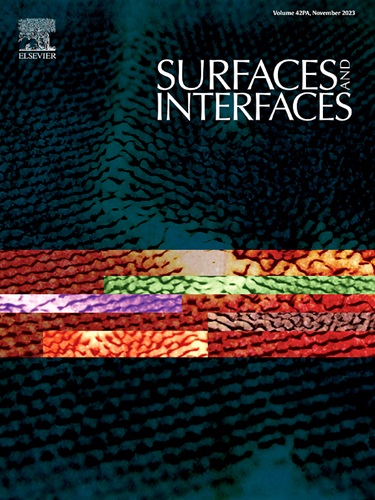超声振动辅助激光熔覆原位NbC增强In625熔覆层的力学性能和高温抗氧化性分析
IF 6.3
2区 材料科学
Q2 CHEMISTRY, PHYSICAL
引用次数: 0
摘要
本研究探讨了超声振动与激光熔覆结合对原位NbC增强In625熔覆层形成和性能的影响,重点研究了不同超声功率(0-440 W)下的显微组织特征、力学性能和耐高温氧化性。超声振动显著增强了NbC的形成,细化了晶粒尺寸,改善了颗粒分布的均匀性。在330 W时观察到最佳力学性能,显微硬度提高20.2 HV,磨损体积减少22.8%,同时磨损机制从粘着磨损转变为疲劳磨损。在800°C、60 h的高温氧化条件下,形成了Cr2O3、Nb2O5、NiO和NiCr2O4氧化物,在330 W的环境下表现出优异的抗氧化性能——增益为2.67 mg/cm2,氧化层厚度为3.65 μm,明显低于非超声样品。然而,当超声功率进一步增加到440 W时,熔覆层的显微硬度降低,耐磨性下降,耐高温氧化能力下降。这表明超声波功率不应超过一定的限制,因为过大的功率会对包层的性能产生不利影响。这些发现强调了超声波振动在提高NbC增强In625包层性能方面的有效性,为提高高温抗氧化性提供了有价值的见解。本文章由计算机程序翻译,如有差异,请以英文原文为准。

In-situ NbC reinforced In625 claddings by ultrasonic vibration-assisted laser cladding: Mechanical properties and high-temperature oxidation resistance analysis
This study explores how ultrasonic vibration integrated with laser cladding influences the formation and performance of in-situ NbC reinforced In625 claddings, focusing on microstructural characteristics, mechanical properties, and resistance to high-temperature oxidation under varying ultrasonic powers (0–440 W). Ultrasonic vibration notably enhances NbC formation, refines grain size, and improves particle distribution uniformity. Optimal mechanical properties were observed at 330 W, with a 20.2 HV increase in microhardness and a 22.8 % reduction in wear volume, alongside a transition in wear mechanism from adhesive to fatigue wear. High-temperature oxidation tests at 800 °C for 60 h revealed the formation of Cr2O3, Nb2O5, NiO, and NiCr2O4 oxides, with the 330 W setting demonstrating superior oxidation resistance—2.67 mg/cm2 wt gain and a 3.65 μm oxide layer, significantly lower than non-ultrasonic samples. However, as the ultrasonic power was further increased to 440 W, the cladding exhibited reduced microhardness, diminished wear resistance, and a decline in its ability to withstand high-temperature oxidation. This indicates that ultrasonic power should not exceed a certain limit, as excessive power can adversely affect the performance of the cladding. These findings underscore the efficacy of ultrasonic vibration in enhancing the performance of NbC reinforced In625 claddings, offering valuable insights for improving high-temperature oxidation resistance.
求助全文
通过发布文献求助,成功后即可免费获取论文全文。
去求助
来源期刊

Surfaces and Interfaces
Chemistry-General Chemistry
CiteScore
8.50
自引率
6.50%
发文量
753
审稿时长
35 days
期刊介绍:
The aim of the journal is to provide a respectful outlet for ''sound science'' papers in all research areas on surfaces and interfaces. We define sound science papers as papers that describe new and well-executed research, but that do not necessarily provide brand new insights or are merely a description of research results.
Surfaces and Interfaces publishes research papers in all fields of surface science which may not always find the right home on first submission to our Elsevier sister journals (Applied Surface, Surface and Coatings Technology, Thin Solid Films)
 求助内容:
求助内容: 应助结果提醒方式:
应助结果提醒方式:


